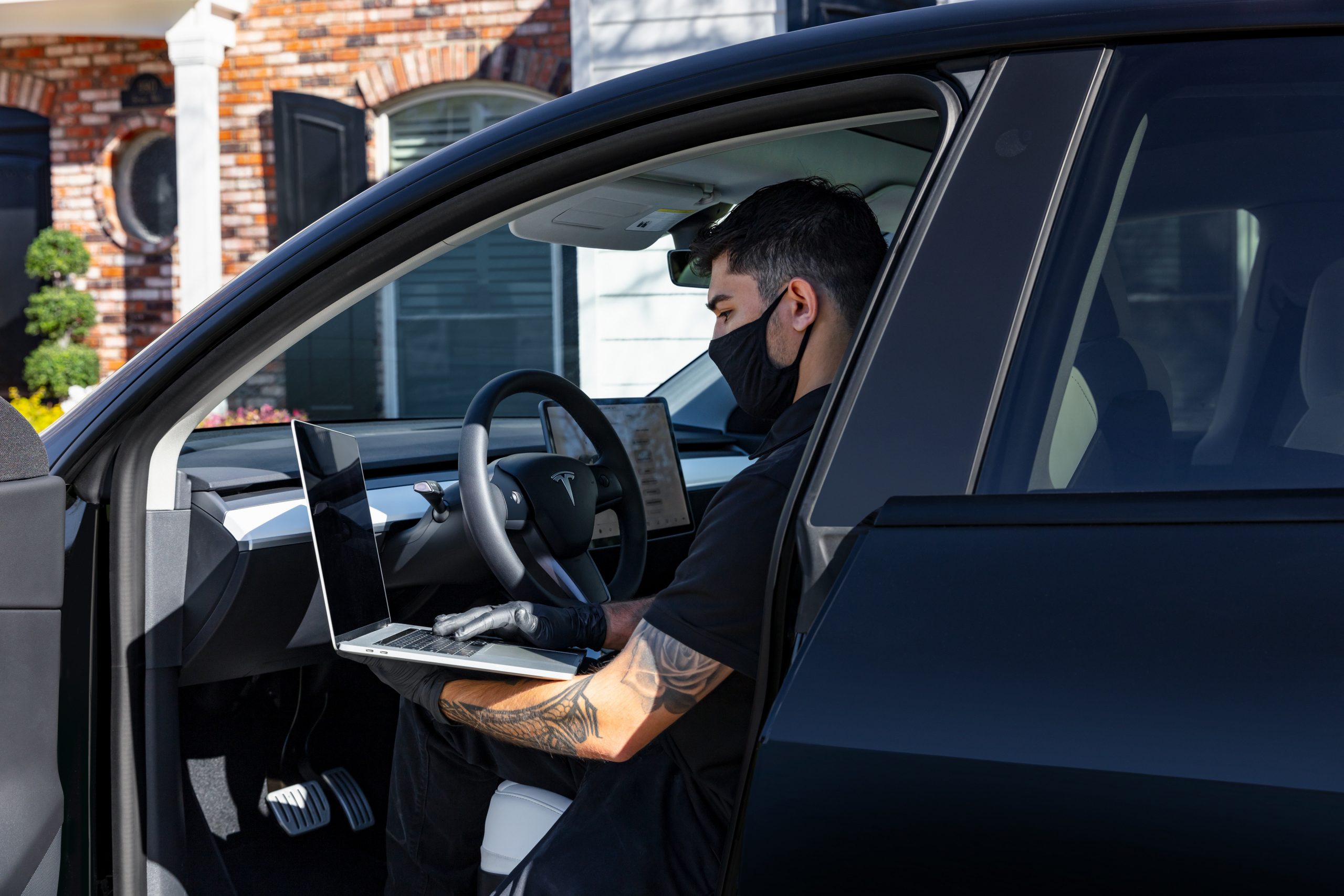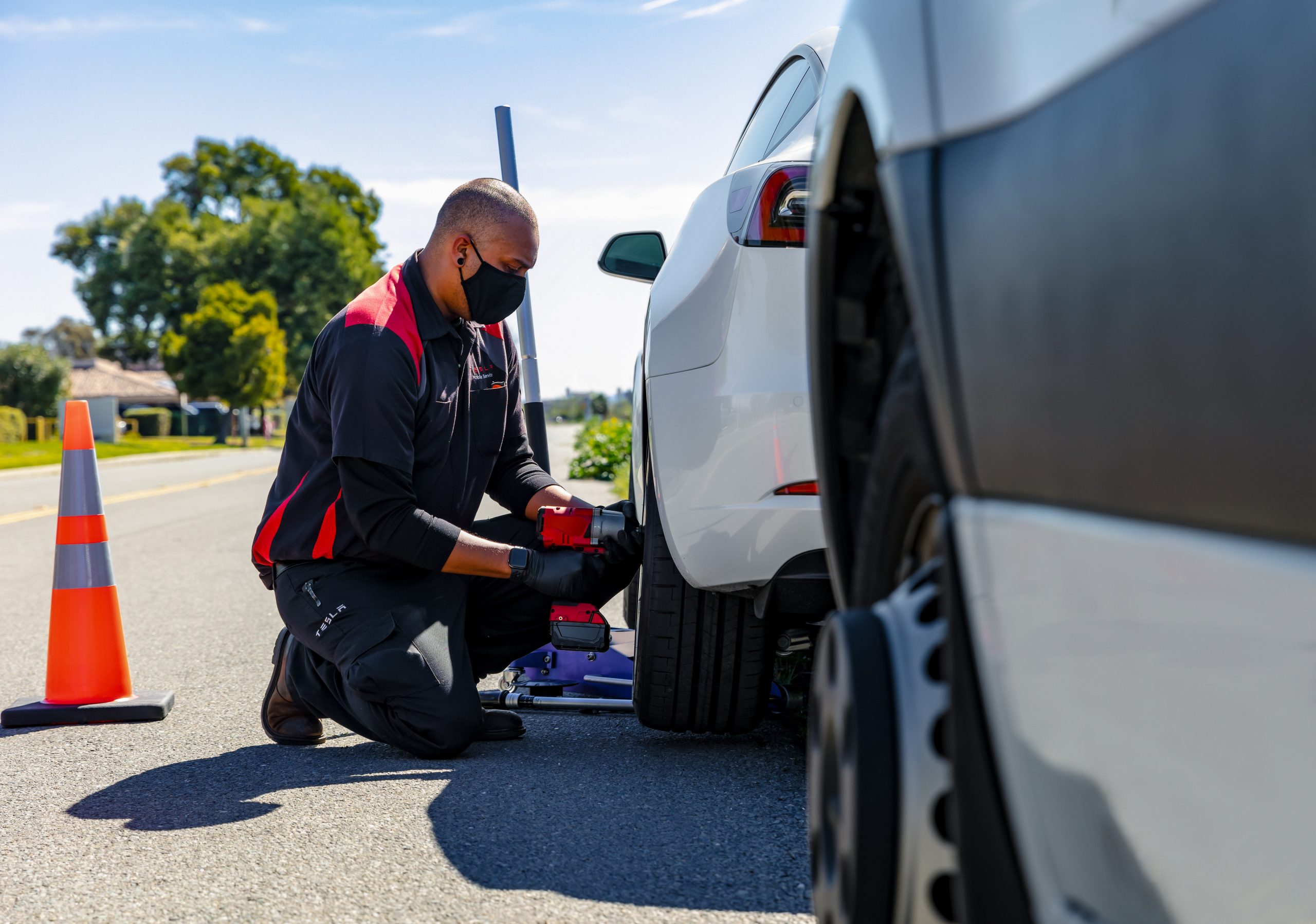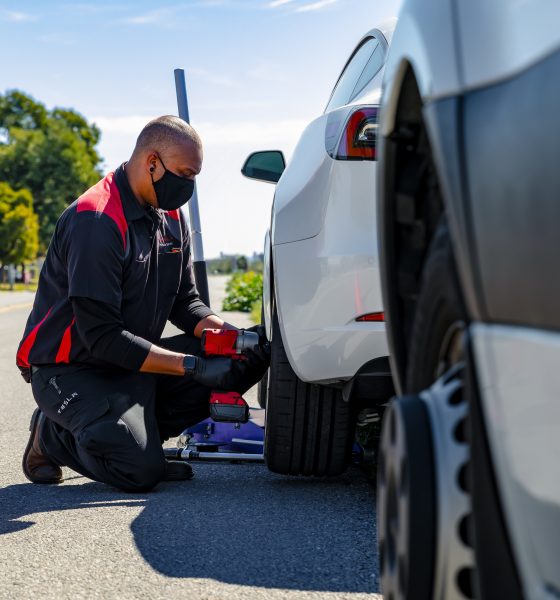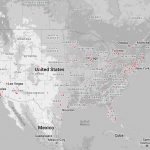Last week, Elon Musk tweeted in a series of updates that Tesla would be attempting to service two-thirds of customer requests “same day.”
One of the many benefits of owning an electric vehicle is the lack of service required. According to Autoblog, of the top 5 most common car repairs – oxygen sensor replacement, inspection of loose fuel cap causing engine light, catalytic converter replacement, mass airflow sensor replacement, and spark plug replacement – none of them are even possible on an electric vehicle. Nonetheless, due to a range of issues, Tesla has had a consistent problem with servicing its ever-growing group of customers’ needs. Musk is set out to change this, and owners should have many reasons to be optimistic!
Working on Tesla North American service.
Goal is 2/3 of cars receive same-day service, no wait.
— Elon Musk (@elonmusk) June 4, 2022
Looking at Tesla’s service problem, it is multifaceted and often self-feeding in nature. To start off, quality control at Tesla has been a known problem, with customers experiencing everything from missing badges to paint issues to panel gaps. All of these issues must be serviced, and much of this service will be done at one of the company’s service centers.
Quality control (QC) service requests, when combined with normal service load, mean that Tesla service centers’ availability is often impaired. Tesla Motors Club forum even has a thread dedicated for service center wait times. This means that customers may be forced to wait longer periods before service, and if the service is not done 100% correctly the first time, the service center doesn’t have the capacity to bring them back immediately.
This lack of availability is compounded by Tesla’s lack of service centers as a whole, some states having only single-digit numbers of service centers available. This means that the service centers that do exist are responsible for a larger number of vehicles. And while independent service centers exist commonly throughout the US, many refuse to work on Tesla products or any electric vehicles for that matter, even when they have the capability to do the work. Once again, this forces more service requests to Tesla service centers.
Credit: Tesla
Finally, because new car QC requests are often covered by Tesla at no cost, this incentivizes customers to go to service centers for free work instead of going to independent shops that may be able to help them.
These problems have not been ignored by Elon Musk, and since 2018, Tesla has addressed many of these concerns. Most predominantly, since 2018, the number of service centers and the area that they cover has increased drastically. Looking at a map of 2018 and comparing it to now, areas such as New England, the Pacific Northwest, and the South have all seen massive increases in capacity. Tesla aimed to open one new Service Center per week in 2021, and, in general, the automaker has experimented with many different specialized service programs.
- Map of Tesla service centers in the US as of 2018.
- Map of Tesla service centers in the US in 2022
This is combined with an increase in capacity in Tesla’s mobile repair teams, who can often address service requests before the customer has to come to a service center. And in more recent news, Tesla has even made their repair manual free for customers to access, allowing more repairs to be done outside of service centers.
Another obvious change consumers have seen is an improvement in QC. Even according to JD Power’s rankings of brands by initial quality, from 2020 to 2021, Tesla has reduced the number of “problems per 100 vehicles” from 250 in 2020 to 231 in 2021, a number that is competitive with brands like Audi (240) and VW (213).
Service centers themselves have also been changed over the past 4 years with the inclusion of F1 style pit lanes that allow customers to be more quickly addressed and hence allow the service team to address more requests in a day.
Nonetheless, many have been concerned that these changes have not been enough to fix the Tesla service issue. Leading many to think about what could be done to improve the situation. A couple of options have been put forward by industry professionals and Twitter users alike. One such suggestion has been the expansion of the Tesla START program, a program that teaches individuals how to work on Teslas and then places them with a full-time job at a Service Center location across the country. Currently, the program is offered at eight colleges across the country: Rio Honda Community College in Los Angeles, Central Piedmont Community College in Charlotte, North Carolina, Shoreline Community College in Seattle, Evergreen Valley College in San Jose, California, Suffolk Community College in Selden, New York, Miami Dade College in Florida, Texas State Technical College in Waco, Texas, and Sinclair Community College in Dayton, Ohio.
Overall, the changes made in the past 4 years should give Tesla’s current and future customers much to be optimistic about. QC has improved, the speed of service operation has increased, service manuals are free and open to anyone, and the number of service centers has increased. The only question is, what is Elon Musk planning on implementing next to improve Tesla’s Service department?
What do you think of the article? Do you have any comments, questions, or concerns? Shoot me an email at william@teslarati.com. You can also reach me on Twitter @WilliamWritin. If you have news tips, email us at tips@teslarati.com

News
Tesla (TSLA) receives “Buy” rating and $551 PT from Canaccord Genuity
He also maintained a “Buy” rating for TSLA stock over the company’s improving long-term outlook, which is driven by autonomy and robotics.

Canaccord Genuity analyst George Gianarikas raised his Tesla (NASDAQ:TSLA) price target from $482 to $551. He also maintained a “Buy” rating for TSLA stock over the company’s improving long-term outlook, which is driven by autonomy and robotics.
The analyst’s updated note
Gianarikas lowered his 4Q25 delivery estimates but pointed to several positive factors in the Tesla story. He noted that EV adoption in emerging markets is gaining pace, and progress in FSD and the Robotaxi rollout in 2026 represent major upside drivers. Further progress in the Optimus program next year could also add more momentum for the electric vehicle maker.
“Overall, yes, 4Q25 delivery expectations are being revised lower. However, the reset in the US EV market is laying the groundwork for a more durable and attractive long-term demand environment.
“At the same time, EV penetration in emerging markets is accelerating, reinforcing Tesla’s potential multi‑year growth runway beyond the US. Global progress in FSD and the anticipated rollout of a larger robotaxi fleet in 2026 are increasingly important components of the Tesla equity story and could provide sentiment tailwinds,” the analyst wrote.
Tesla’s busy 2026
The upcoming year would be a busy one for Tesla, considering the company’s plans and targets. The autonomous two-seat Cybercab has been confirmed to start production sometime in Q2 2026, as per Elon Musk during the 2025 Annual Shareholder Meeting.
Apart from this, Tesla is also expected to unveil the next-generation Roadster on April 1, 2026. Tesla is also expected to start high-volume production of the Tesla Semi in Nevada next year.
Apart from vehicle launches, Tesla has expressed its intentions to significantly ramp the rollout of FSD to several regions worldwide, such as Europe. Plans are also underway to launch more Robotaxi networks in several more key areas across the United States.
News
Waymo sues Santa Monica over order to halt overnight charging sessions
In its complaint, Waymo argued that its self-driving cars’ operations do not constitute a public nuisance, and compliance with the city’s order would cause the company irreparable harm.

Waymo has filed a lawsuit against the City of Santa Monica in Los Angeles County Superior Court, seeking to block an order that requires the company to cease overnight charging at two facilities.
In its complaint, Waymo argued that its self-driving cars’ operations do not constitute a public nuisance, and compliance with the city’s order would cause the company irreparable harm.
Nuisance claims
As noted in a report from the Los Angeles Times, Waymo’s two charging sites at Euclid Street and Broadway have operated for about a year, supporting the company’s growing fleet with round-the-clock activity. Unfortunately, this has also resulted in residents in the area reportedly being unable to sleep due to incessant beeping from self-driving taxis that are moving in and out of the charging stations around the clock.
Frustrated residents have protested against the Waymos by blocking the vehicles’ paths, placing cones, and “stacking” cars to create backups. This has also resulted in multiple calls to the police.
Last month, the city issued an order to Waymo and its charging partner, Voltera, to cease overnight operations at the charging locations, stating that the self-driving vehicles’ activities at night were a public nuisance. A December 15 meeting yielded no agreement on mitigations like software rerouting. Waymo proposed changes, but the city reportedly insisted that nothing would satisfy the irate residents.
“We are disappointed that the City has chosen an adversarial path over a collaborative one. The City’s position has been to insist that no actions taken or proposed by Waymo would satisfy the complaining neighbors and therefore must be deemed insufficient,” a Waymo spokesperson stated.
Waymo pushes back
In its legal complaint, Waymo stated that its “activities at the Broadway Facilities do not constitute a public nuisance.” The company also noted that it “faces imminent and irreparable harm to its operations, employees, and customers” from the city’s order. The suit also stated that the city was fully aware that the Voltera charging sites would be operating around the clock to support Waymo’s self-driving taxis.
The company highlighted over one million trips in Santa Monica since launch, with more than 50,000 rides starting or ending there in November alone. Waymo also criticized the city for adopting a contentious strategy against businesses.
“The City of Santa Monica’s recent actions are inconsistent with its stated goal of attracting investment. At a time when the City faces a serious fiscal crisis, officials are choosing to obstruct properly permitted investment rather than fostering a ‘ready for business’ environment,” Waymo stated.
News
Tesla FSD v14.2.2 is getting rave reviews from drivers
So far, early testers have reported buttery-smooth drives with confident performance, even at night or on twisty roads.

Tesla Full Self-Driving (Supervised) v14.2.2 is receiving positive reviews from owners, with several drivers praising the build’s lack of hesitation during lane changes and its smoother decision-making, among others.
The update, which started rolling out on Monday, also adds features like dynamic arrival pin adjustment. So far, early testers have reported buttery-smooth drives with confident performance, even at night or on twisty roads.
Owners highlight major improvements
Longtime Tesla owner and FSD user @BLKMDL3 shared a detailed 10-hour impression of FSD v14.2.2, noting that the system exhibited “zero lane change hesitation” and “extremely refined” lane choices. He praised Mad Max mode’s performance, stellar parking in locations including ticket dispensers, and impressive canyon runs even in dark conditions.
Fellow FSD user Dan Burkland reported an hour of FSD v14.2.2’s nighttime driving with “zero hesitations” and “buttery smooth” confidence reminiscent of Robotaxi rides in areas such as Austin, Texas. Veteran FSD user Whole Mars Catalog also demonstrated voice navigation via Grok, while Tesla owner Devin Olsen completed a nearly two-hour drive with FSD v14.2.2 in heavy traffic and rain with strong performance.
Closer to unsupervised
FSD has been receiving rave reviews, even from Tesla’s competitors. Xpeng CEO He Xiaopeng, for one, offered fresh praise for FSD v14.2 after visiting Silicon Valley. Following extended test drives of Tesla vehicles running the latest FSD software, He stated that the system has made major strides, reinforcing his view that Tesla’s approach to autonomy is indeed the proper path towards autonomy.
According to He, Tesla’s FSD has evolved from a smooth Level 2 advanced driver assistance system into what he described as a “near-Level 4” experience in terms of capabilities. While acknowledging that areas of improvement are still present, the Xpeng CEO stated that FSD’s current iteration significantly surpasses last year’s capabilities. He also reiterated his belief that Tesla’s strategy of using the same autonomous software and hardware architecture across private vehicles and robotaxis is the right long-term approach, as it would allow users to bypass intermediate autonomy stages and move closer to Level 4 functionality.












